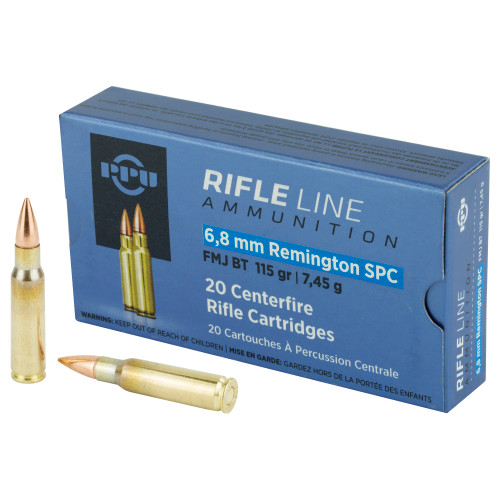-

-

-

-

Sellier & Bellot Ammo
Sellier and Bellot 6.8 Remington SPC Rifle 110gr PolyTip Ammo
$30.05 - $800.60 -

-

Remington Ammo
Remington 6.8 Rem SPC Premier Match 115gr Sierra MatchKing BTHP Ammo
$41.23 - $378.14 -

-

Winchester Ammo
Winchester 6.8 Remington SPC Deer Season XP 115gr Extreme Point Ammo
$37.27 - $318.04 -

-

-

-

Nosler Ammo
Nosler 6.8 Remington SPC Custom Competition Match Grade 115gr JHP Ammo
$48.05 - $1,640.13
6.8mm Remington SPC Ammo
Professionally Reviewed by:
Nathaniel Boos

Nathaniel Boos is a lifelong firearms enthusiast and shooter, renowned for his experience as a long-range shooter, ammunition importer/exporter, and firearms manufacturer. With years of hands-on experience, he is a trusted authority in the ammunition and firearms industry.
Credentials:
- • 2x Team Safari Competitor
- • KRG Training Level 1, 2, and Force on Force CQB certified
- • Licensed Texas Conceal Carry Holder
- • Kranz Firearms Training Group Advanced Carbine Certified
6.8mm Remington SPC: At a Glance
| Key Characteristics | |
|---|---|
| Firearm Type | Rifle, Carbine |
| Primer Type | Small Rifle |
| Used For | Military, Law Enforcement, Hunting, Sport Shooting |
| Case Design | Rimless, Bottleneck |
| Year Introduced | 2004 |
6.8mm Remington SPC: Pros and Cons
Pros
- ✔ Improved terminal ballistics over 5.56mm NATO
- ✔ Better performance in short-barreled rifles
- ✔ Effective for medium-sized game hunting
- ✔ Moderate recoil, manageable in AR-15 platforms
- ✔ Good balance of power and controllability
Cons
- ✘ Less common than 5.56mm NATO or .223 Remington
- ✘ Higher ammunition cost compared to 5.56mm
- ✘ Reduced magazine capacity in standard AR-15 magazines
- ✘ Shorter effective range than some larger calibers
- ✘ Less barrel life compared to 5.56mm NATO
6.8mm Remington SPC: A Comprehensive Overview
The 6.8mm Remington SPC (Special Purpose Cartridge) is a rifle cartridge developed to bridge the gap between the 5.56mm NATO and 7.62mm NATO rounds. It was designed to offer improved terminal ballistics over the 5.56mm NATO, particularly in short-barreled rifles.
Development and History
The 6.8mm Remington SPC was developed in the early 2000s as a collaborative effort between the U.S. Army's Marksmanship Unit, the United States Special Operations Command (USSOCOM), and Remington Arms. The goal was to create a cartridge that could outperform the 5.56mm NATO in terms of terminal ballistics, especially from shorter-barreled rifles commonly used in close-quarters combat.
The 6.8 SPC is based on the .30 Remington case, shortened and necked down to accept a 6.8mm (.277 caliber) bullet. This design allows for compatibility with the AR-15 platform, requiring only a barrel, bolt, and magazine change to convert existing rifles.
While the 6.8 SPC did not replace the 5.56mm NATO as the standard U.S. military cartridge, it has found success in certain special operations units and has gained popularity in the civilian market for hunting and self-defense applications.
Performance Characteristics
The 6.8mm Remington SPC offers a significant increase in muzzle energy compared to the 5.56mm NATO, while maintaining manageable recoil. It typically fires bullets weighing between 85 and 120 grains, with muzzle velocities ranging from 2,500 to 2,800 feet per second, depending on the specific load and barrel length.
6.8mm Remington SPC Performance
The 6.8mm Remington SPC offers improved ballistic performance over the 5.56mm NATO, particularly in short-barreled rifles. Here's a breakdown of its key performance characteristics:
| Characteristic | Performance |
|---|---|
| Bullet Weight | 85-120 grains Common bullet weights for various applications |
| Muzzle Velocity | 2,500-2,800 fps Varies based on bullet weight and barrel length |
| Muzzle Energy | 1,600-1,800 ft-lbs Significantly higher than 5.56mm NATO |
| Effective Range | 300-500 yards Suitable for medium-range engagements |
| Recoil | Moderate Higher than 5.56mm NATO but still manageable in AR-15 platform |
Bullet Weight vs. Muzzle Velocity
This chart shows how bullet weight affects muzzle velocity for common 6.8mm Remington SPC loads.
6.8mm Remington SPC: Effective Range for Different Applications
This table provides estimated effective ranges for 6.8mm Remington SPC ammunition in various applications. Ranges are based on typical bullet weights and velocities.
| Application | Effective Range (yards) | Notes |
|---|---|---|
| Military/Combat | 0-600 | Effective for most combat scenarios, improved terminal ballistics over 5.56mm NATO |
| Law Enforcement | 0-400 | Suitable for urban and rural engagements, good penetration and stopping power |
| Hunting (Medium Game) | 0-350 | Excellent for medium game, suitable for deer, hogs, and similar-sized animals |
| Target Shooting | 0-700 | Capable of long-range accuracy with proper loads and rifle configuration |
| Self-Defense | 0-200 | Effective stopping power, but overpenetration is a significant concern in close quarters |
Note: Effective ranges can vary based on factors such as bullet selection, shooter skill, wind conditions, and specific firearm characteristics. The 6.8mm Remington SPC is known for its improved terminal ballistics and effective range compared to the 5.56mm NATO. Always prioritize safety and adhere to local laws and regulations.
Applications for 6.8mm Remington SPC
The 6.8mm Remington SPC's performance profile makes it suitable for a range of applications:
6.8mm Remington SPC Comparisons
To understand the 6.8mm Remington SPC's place in the rifle world, it's helpful to compare it to similar cartridges. Click on each comparison to see more details:
Recoil Energy Comparison
Compare the estimated recoil energy of 6.8mm Remington SPC with other popular rifle cartridges. (Based on a 7.5 lb rifle)
Ballistic Trajectory Comparison
This chart compares the ballistic trajectory (bullet drop) of 6.8mm Remington SPC with other popular rifle cartridges over distance.
Wind Drift Comparison
This chart compares the wind drift of 6.8mm Remington SPC with other popular rifle cartridges in a 10 mph crosswind.
Energy Retention Comparison
This chart compares the energy retention of 6.8mm Remington SPC with other popular rifle cartridges over distance.
Sectional Density Comparison for 6.8mm Remington SPC
The 6.8mm Remington SPC (Special Purpose Cartridge) was developed to improve upon the 5.56mm NATO's performance in short-barreled rifles. This comparison shows its sectional density against similar cartridges.
| Cartridge | Bullet Weight (gr) | Sectional Density |
|---|---|---|
| 6.8mm Remington SPC | 115 | 0.242 |
| 5.56x45mm NATO | 62 | 0.177 |
| .300 Blackout | 125 | 0.188 |
| 6.5 Grendel | 123 | 0.252 |
| 7.62x39mm | 123 | 0.184 |
Note: The 6.8mm Remington SPC offers improved sectional density compared to the 5.56mm NATO and 7.62x39mm, potentially providing better penetration and energy retention at medium ranges. Its performance is comparable to the 6.5 Grendel in terms of sectional density.